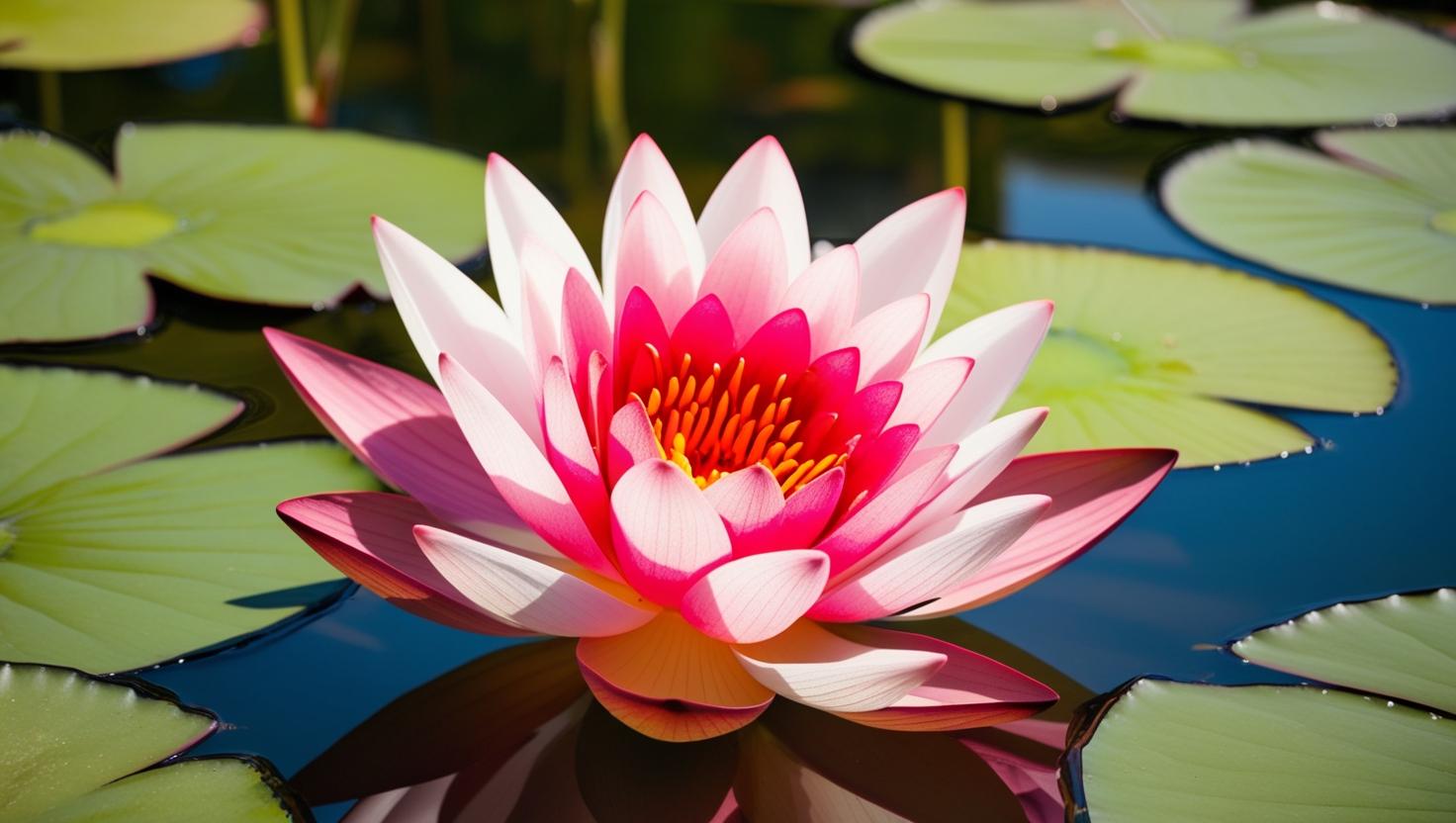The lotus is far more than just a beautiful flower—it is a deeply revered symbol across India and much of Asia. Renowned for its ability to bloom in muddy waters while remaining unstained, the lotus represents purity, resilience, and spiritual awakening. This remarkable quality has made it a central motif in both religious and cultural contexts for thousands of years.
In Vastu Shastra, the ancient Indian science of architecture and space design, the lotus is seen as a symbol of peace, prosperity, and positive energy. It is often used in home decor, temple architecture, and artwork to attract spiritual harmony and balance. Meanwhile, in spiritual traditions like Hinduism and Buddhism, the lotus plays a sacred role—it is associated with divine figures such as Lakshmi, Saraswati, and Buddha, and symbolizes enlightenment, divine beauty, and detachment from material life. Its presence in both Vastu and spiritual iconography underscores the lotus’s unique role as a bridge between the physical and the spiritual realms.
The Lotus as a Symbol of Purity
The lotus, which emerges pristine and vibrant from murky, muddy waters, powerfully symbolizes purity, resilience, and spiritual transformation. Its unique growth pattern — rooted in the dirt yet untouched by it — represents the ability to rise above one’s circumstances, making it a metaphor for inner strength and moral clarity.
In spiritual traditions, especially Hinduism and Buddhism, the lotus is deeply associated with detachment from materialism. Just as the lotus remains untouched by the water in which it grows, a spiritually awakened person is expected to live in the world without being consumed by worldly desires or distractions. This ideal of non-attachment is essential for spiritual growth.
The lotus is also seen as a powerful metaphor for rising above suffering. Just as the flower rises from mud to bloom in sunlight, the human soul, through discipline and devotion, is believed to transcend pain, illusion, and ignorance, reaching a state of enlightenment or liberation. It is this symbolism that makes the lotus one of the most enduring icons of spiritual aspiration across Asian cultures.
The Spiritual Importance of the Lotus
In Hinduism
- Goddess Lakshmi is often depicted seated on a fully bloomed lotus, symbolizing wealth, purity, and spiritual power untouched by material corruption.
- Lord Brahma, the creator god, is described in mythology as emerging from a lotus that grows from the navel of Lord Vishnu — signifying divine birth and creation.
- The lotus symbolizes divine beauty, fertility, and spiritual enlightenment in many Hindu scriptures and iconography.
In Buddhism
- The lotus is a central symbol of enlightenment and spiritual awakening.
- It represents the path from ignorance to Nirvana, with the flower’s growth (from mud to bloom) symbolizing the journey from suffering to liberation.
- Different colors of lotus (white, pink, blue, red) signify different aspects of the Buddha’s teachings (e.g., purity, compassion, wisdom).
In Yogic and Chakra Systems
- The Sahasrara (crown) chakra, located at the top of the head, is traditionally depicted as a thousand-petaled lotus, representing the point of cosmic connection and union with the divine.
- Lotus imagery is also found in other chakras, symbolizing energy centers that must “open” like flowers during spiritual practice.
The Lotus in Vastu Shastra
Lotus in Vastu: A Symbol of Positive Energy, Prosperity & Peace
- The lotus flower is not just spiritually significant but also holds a powerful place in Vastu Shastra, the ancient Indian science of architecture and energy balance.
- It symbolizes purity rising from the mud, much like positivity and spiritual growth rising above worldly chaos.
- In Vastu, the lotus is seen as a harbinger of peace, prosperity, and divine energy.
How to Use Lotus Symbolism in Your Home
- Living Rooms & Puja Spaces: Placing lotus-themed art or sculptures in these areas invites serenity and elevates the spiritual vibration of the home.
- Entryways: A lotus motif near the main entrance is believed to attract positive energy and keep negativity out.
Placement Tips According to Vastu
- Northeast (Ishaan corner): Ideal for placing lotus images or paintings. This direction is sacred in Vastu and associated with spiritual growth and divine blessings.
- Pink Lotus: Associated with love, beauty, and wealth — perfect for attracting abundance.
- White Lotus: Symbolizes peace, purity, and enlightenment — best used in meditation or prayer spaces for calm and clarity.
Lotus Motifs in Traditional Architecture
Lotus in Temple and Stupa Architecture
The lotus flower is not just a spiritual symbol, but a foundational design element in sacred architecture across India and Asia, where it represents divinity, purity, and the unfolding of spiritual wisdom.
Lotus Domes and Bases
- Temple domes (shikharas) and stupa bases are often shaped like a blooming lotus.
- This design reflects the idea of the divine rising out of the earthly world — just as the lotus rises from muddy water.
- It creates a visual metaphor for spiritual ascent and enlightenment.
Lotus Carvings in Sacred Architecture
- Doorways and Pillars: Lotus motifs are intricately carved on entrances and support columns in Hindu, Buddhist, and Jain temples — symbolizing auspiciousness and divine energy entering the space.
- Mandala Designs: Lotus petals often form the foundation of mandalas in Tibetan and Indian traditions, symbolizing layers of spiritual understanding.
- Ancient Khmer and Tibetan Architecture: In temples like Angkor Wat or Tibetan stupas, lotus carvings appear in layers, especially in base moldings and decorative cornices — tying the structure to cosmic and spiritual principles.
Modern Usage and Relevance
Modern Use of the Lotus: From Tradition to Contemporary Spaces
The lotus flower, long revered in ancient architecture and spiritual art, continues to inspire modern design and decor — seamlessly blending tradition with contemporary aesthetics.
In Home Décor & Vastu-Aligned Interiors
- The lotus is frequently featured in wall art, sculptures, wallpapers, and rangoli designs.
- In Vastu Shastra, it is believed to attract positive energy, serenity, and prosperity, especially when placed in northeast corners or puja spaces.
- Pink or white lotus patterns are popular for their calming and auspicious qualities.
In Yoga Studios & Meditation Spaces
- Lotus motifs are commonly seen in yoga centers, meditation rooms, and spiritual retreats.
- They symbolize inner peace, focus, and spiritual awakening — aligning well with yogic goals of detachment and enlightenment.
- The lotus position (Padmasana) itself is a foundational posture in yoga and meditation.
Cultural Symbolism
- The lotus is India’s national flower, reflecting its deep spiritual and philosophical roots.
- It symbolizes eternal beauty, divine birth, and purity, making it a recurring symbol in art, currency, literature, and national emblems.
- Across time, the lotus has remained a timeless icon, cherished in rituals, architecture, and aesthetics.
Conclusion
The lotus stands as one of the most profound and enduring symbols in both spiritual traditions and Vastu Shastra, embodying values that are essential to inner and outer harmony. More than just a flower, it represents the power of rising above challenges, remaining untouched by negativity — just as it blooms pristine from muddy waters.
In spirituality, the lotus signifies purity, enlightenment, and divine connection, frequently seen in association with deities and meditation practices. In Vastu, it is known to generate positive vibrations, usher in peace, and attract prosperity and balance into the home.
Incorporating lotus symbolism into your space — whether through artwork, decor, or motifs — is more than aesthetic; it is an invitation to purity, growth, and resilience. Be it in a meditation corner, entrance area, or living room, the presence of the lotus can elevate your surroundings and support your spiritual and energetic well-being.
FAQ
How is the lotus used in Vastu Shastra?
Lotus motifs are used to attract peace, prosperity, and positive energy, especially when placed in the northeast corner of a space.
What colors of lotus are best for home decor?
Pink and white lotus symbols are ideal, representing serenity, wealth, and spiritual growth.
Can lotus motifs be used in modern interior design?
Yes, lotus designs are popular in yoga studios, meditation rooms, and Vastu-aligned homes for their calming and spiritual impact.
What is the significance of the lotus in religious art and architecture?
Lotus bases and domes are common in temples and stupas, symbolizing divine birth and spiritual elevation.

